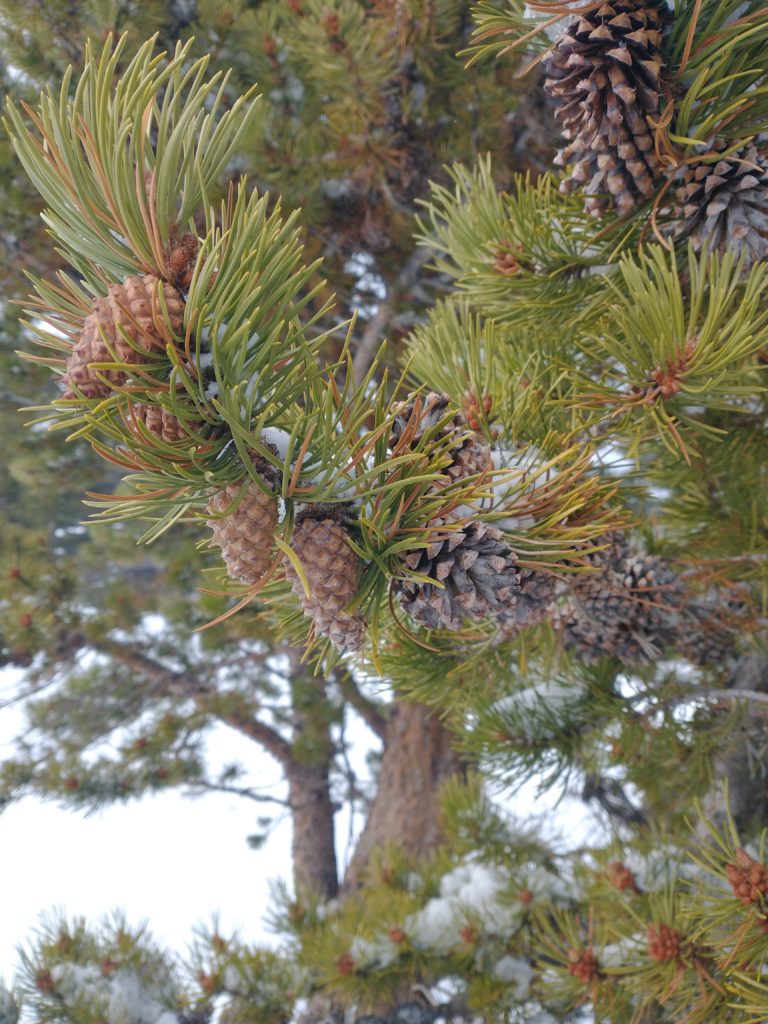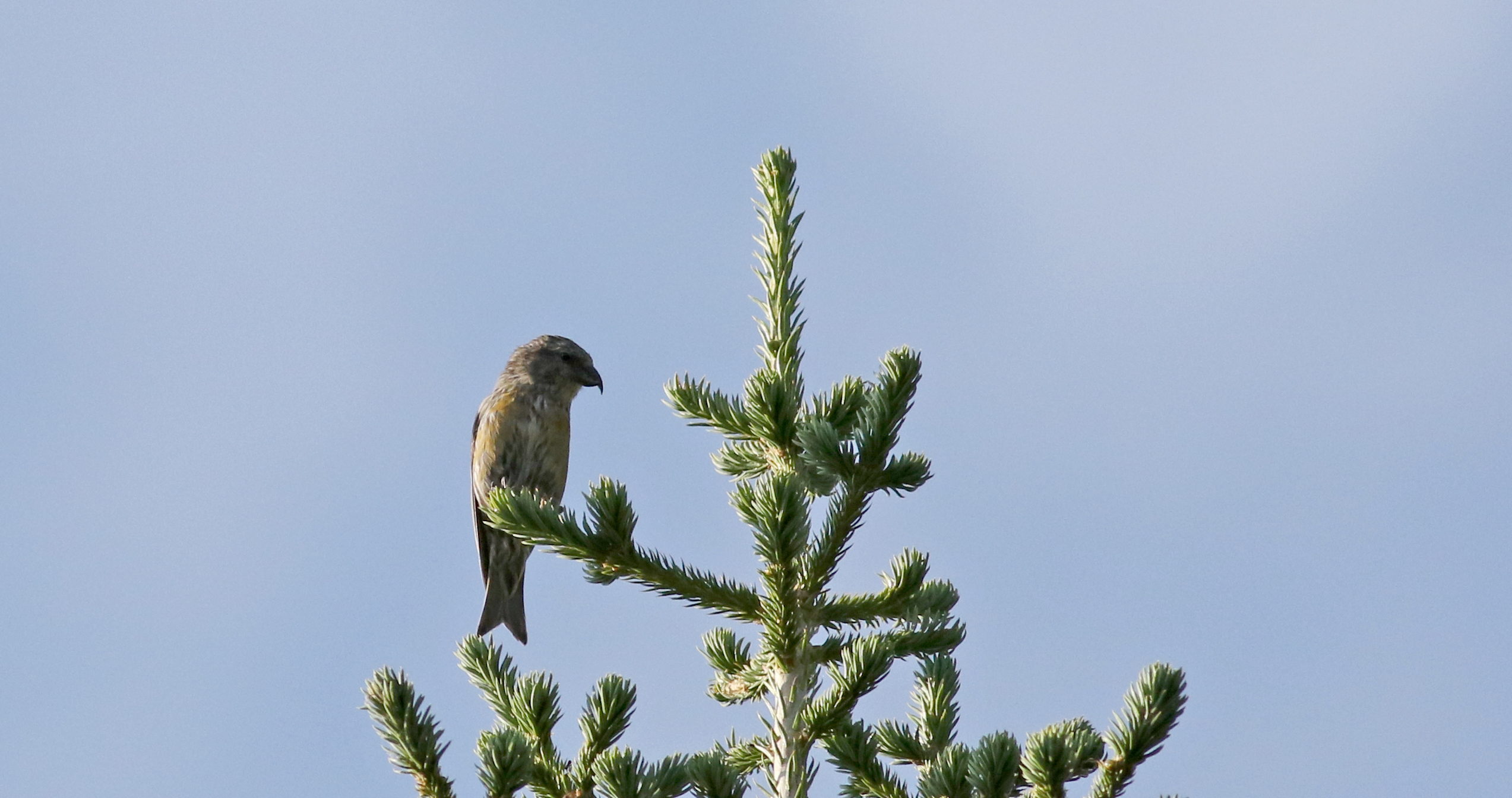Cassia Crossbill in Colorado
By: Christian Nunes.
Most birders fantasize about finding über rarities, wayward travelers from distant continents plopped down on the local pond or skulking through the trees at a migrant trap. When a Yellow Grosbeak showed up at a birdfeeder in Huerfano County, Colorado, on May 28, 2021, one could almost hear the squealing of car tires as birders from across the state hit the pavement for the chase. Finding a mega rarity wasn’t quite my prerogative as I headed up into the vast Colorado Rockies on July 15, 2021. Rather, as I traveled over Berthoud Pass, past lingering snow banks and through throngs of summer tourists in Winter Park, I was aiming to observe breeding birds and butterflies in a few quiet pockets of wilderness beyond the busy highways.
By evening, I had arrived at my intended destination – a well worn dispersed camping site in the Arapaho Roosevelt National Forest outside Tabernash, CO. Soon, a La Cumbre IPA was in my hand and I had macaroni cooking on the camp stove. A small thunderstorm blew through, with a double rainbow forming in its wake. As the golden hour light filtered through the sparse lodgepole pine trees, I heard my first crossbills “clip-clipping” through the forest. I opened the Voice Record application on my phone and started to record the distant calls. In my voice memo, I noted that I had recorded, “calls of a small flock of, maybe, maybe five birds total, ahh, what I presume and suspect are type 5 Red Crossbills, ahh, the last bird there maybe was a type 2, but, ahh, most of them sound better for type 5.”
A double rainbow over sparse lodgepole pines in Grand County, Colorado.
There are two common types of Red Crossbill in Colorado: 2 & 5. Type 4 occurs occasionally, perhaps annually, and there are documented occurrences of the rarer types 1, 3, 6, 7, & 10. The most common type in forested habitats throughout the state is the Ponderosa Pine (type 2) Red Crossbill, which follow the ephemeral seed crops of the ponderosa pine. Type 2 can be abundant at times, but are widely dispersed through a variety of habitats when food is scarce. The less common, but expected, type at higher elevations in Colorado is the Lodgepole Pine (type 5) Red Crossbill. Never as common as type 2, they are still regularly encountered in the lodgepole pine belt between 8,000’-10,000’ elevation. As I stood among the lodgepoles, I assumed that I was listening to type 5s.
I woke the next morning, July 16th, with the sound of perched crossbills calling around my camp. Dissatisfied with my phone recording of the distant flock from the evening prior, I determined to obtain quality type 5 recordings using my Sennheiser ME 66/K6 shotgun microphone and Tascam DR-100mkIII recorder. A group of three crossbills, an adult male, a female, and a juvenile, were foraging in the trees on the edge of camp. I recorded the birds from <20’ as they foraged among the lodgepole pines. After 25 minutes, I had several tracks of various vocalizations, including contact/flight calls, excitement “toop”’ calls, various foraging chitter, and male songs. The lodgepoles had two generations of cones, with old, brown cones sharing the same branch as fresh, green cones. My presumption, as expressed in my recording voice memos, was that the crossbills were, again, type 5 Red Crossbills.

Lodgepole pine cones of various ages from Boulder County, November 2021 (photo by Stephen Hauptli). The trees in Grand County had similar cone conditions in July 2021 except the new generation of cones were greener.
As the sun warmed the cool morning air, a Queen Alexandra’s Sulphur flew by. I returned to my car and swapped my audio recording equipment for my butterfly photography gear. I followed the sulphur and captured some images, decamped, and headed out into the meadows and forests in search of other interesting life forms. Over the next three days I traveled up through Steamboat Springs, down towards Vail, up to Loveland Pass, and eventually back home to my very pregnant wife. I took hundreds of photographs which had to be processed when I returned home. Soon, we had a baby boy, Emmet Francis Nunes, and the distractions compounded. The audio recordings sat in the cupboard.
This Queen Alexandra’s Sulphur basking in the morning light caused a delightful distraction.
Fast-forward to November 9, 2021. While birding with another crossbill aficionado, David Tønnessen, the topic of Colorado Red Crossbill types came up. The local ponderosa pines had a bumper crop in 2020, which attracted several rare types among large flocks of type 2 Red Crossbills. I filled David in on my observations of Enigmatic (type 7) and Western Hemlock (type 3) Red Crossbills in the foothills outside Boulder. This was the first record of Enigmatic for the state. Nick Moore documented Colorado’s first Sitka Spruce (type 10) Red Crossbills in suburban Gunbarrel. David Dowell recorded an Appalachian (type 1) Red Crossbill, another new type for the state, near Gold Lake. I admitted to David that despite having recordings of several rare types, I was still missing audio of the more regular Lodgepole Pine (type 5) Red Crossbill in my eBird archive.
I returned home that night with the goal of analyzing and uploading those “type 5 Red Crossbill” recordings from the summer. I dusted off the old SD card and opened the files in Audacity. As I stared at the spectrograms, I realized I had an über mega. It wasn’t a flashy Mexican Cardinalid, like the Yellow Grosbeak, but the “⑁” shaped signature of the Cassia Crossbill’s “dip-dip-dip” contact calls (recordings can be found here: https://ebird.org/checklist/S91855481). Matt Young and Tim Spahr from the Finch Research Network soon confirmed the find. To the chagrin of state listers, I had sat on the evidence of the first Colorado record of Cassia Crossbill, and really the first record of the species away from Cassia County, Idaho, for almost 4 months.
Spectrogram of Cassia Crossbill contact/flight calls from the Arapaho Roosevelt National Forest in Grand County, Colorado on July 16, 2021.
The Cassia Crossbill is the latest addition to North America’s avifauna. The species is endemic to the South Hills and Albion Mountains of Cassia County, Idaho. The taxon was first described as a new type of Red Crossbill (type 9) by Dr. Craig Benkman in 1999. He noted how the forests of the South Hills and Albion Mountains lacked cone-raiding red squirrels. This left the lodgepole pines to defend themselves against only one seed predator: crossbills. The pine seeds are locked into the cones by a thick, resinous, or serotinous, coating. With no squirrels to remove the cones, the trees become laden with multiple generations of serotinous cones. Only fire or extreme summer temperatures can melt the resin, opening the cones and releasing the seeds en masse. This system provides the Cassia Crossbill with a reliable larder of pine seeds. The crossbills have evolved a larger beak to more effectively pilfer seeds from the heavily defended cones, a sedentary life history capitalizing on a reliable food source, and unique vocalizations that differentiate Cassia from Red Crossbills. Additionally, genetic analyses have demonstrated that the Cassia Crossbill is phylogenetically distinct from the Red Crossbill, although low levels of hybridization have been detected. Research out of the Benkman Lab has revealed the unique ecology, genetic identity, and auditory differentiation of the Cassia Crossbill, leading to its elevation to a full species in 2017.
The crow-flight distance between Cassia County, ID, and Grand County, CO, is 450 mi, crossing through both Utah and Wyoming.
What were these specialized, sedentary crossbills doing 450 mi from their known range? From September 12 through October 15, 2020, the Badger Fire raged across 90,190 acres of the South Hills. This human caused fire wiped out 25% of the known breeding range of the Cassia Crossbill. The displaced birds may not have found vacant territories elsewhere in the South Hills or nearby Albion Mountains, and in true crossbill fashion they began a peregrination in search of food resources. As they dispersed into nearby ranges, they would have encountered competition from type 2 & 5 Red Crossbills, as well as a varied matrix of food availability. Their roving eventually brought them to the sparse, mountain pine beetle ravaged lodgepole pine forests of Grand County, Colorado, where I was fortunate enough to intercept them. The Badger Fire would have released generations of lodgepole pine seeds from the serotinous cones. The forests of the South Hills will recover with time, but only if protected from further disruptions from fire, insect infestations, or an inhospitable climate.
The Badger Fire burned 90,190 acres across the South Hills of Cassia County, ID, in Fall 2020. A significant portion of the Cassia Crossbill’s range was affected.
Birders everywhere can now use their phones to collect sound recordings, which can then be analyzed spectrographically to determine the type, or species, of crossbill involved. This technology is helping us explore the frontiers of crossbill distribution and ecology. The rewards aren’t always as immediate as, say, spotting a Yellow Grosbeak. But, there are still discoveries to be made as we learn more about cryptic species. The Cassia Crossbills may still be wandering the Western forests as they wait for the South Hills to recover. Point those recorders to the sky and remember that it’s not safe to assume crossbill species or type based on habitat or range alone.
Cover Photo Jay McGowan
Christian Nunes:
Christian grew up in Rhode Island, where his passionate interest in birds developed after finding a yellow warbler nest when he was 3. He received a B.S. in Environmental Science from Nothern Arizona University, and a M.S. in Fish, Wildlife, and Conservation Biology from Colorado State University. Currently, Christian is a Wildlife Ecologist for the City of Boulder Open Space and Mountain Parks Department. His professional work focuses on monitoring a variety of wildlife species across the city’s 50,000-acre open space system at the edge of the Great Plains and Rocky Mountains. His free time is spent birding, hiking, and biking around Colorado. email: christianalfrednunes@gmail.com
FiRN is a nonprofit, and has been granted 501c3 status. FiRN is committed to researching and protecting these birds and threatened finch species like the Evening Grosbeak, a species that has declined 92% since 1970. We are actively in the process of fundraising around an Evening Grosbeak Road to Recovery plan in addition to a student research project, so please think about supporting our efforts and making a small donation at the donate link below.

